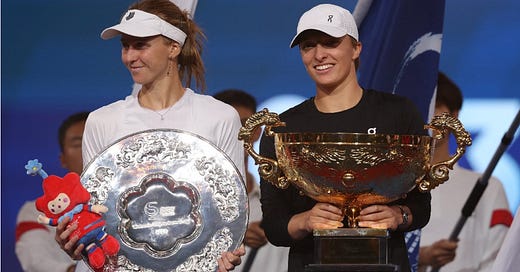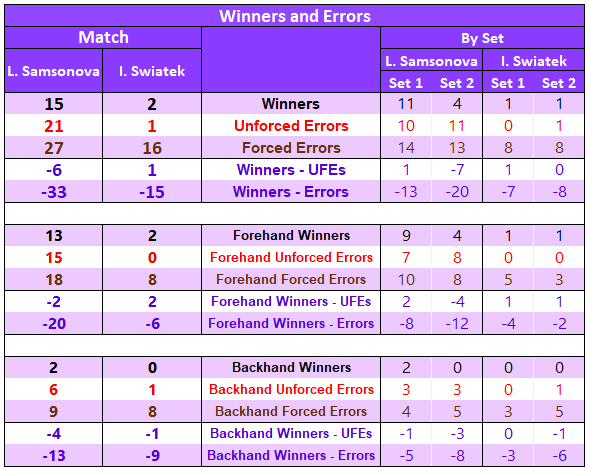Samsonova vs Swiatek: Beijing Final Analysis (WTA 1000)
Two winners, one unforced error (sorry WTA stats!), zero regrets for the gameplan chosen. Iga Swiatek culminated her debut participation in the China Open by mutating into the Great Wall.
It is well known that Swiatek loves to (at times it has looked like she even needs to) take early control of points. But in the Beijing Final, instead of engaging in a race to determine who could strike first, Swiatek challenged Liudmila Samsonova (a lover of first-strike tennis) to beat her by earning each and every point. It was the perfect approach for Swiatek, one that left Samsonova feeling an insurmountable pressure.
“I think this is what she's doing the best because this is the stress that she made to other players, that she doesn't make unforced errors. Every time you need to do something more. It's not real what you feel, but she makes you feel like this.”
— Liudmila Samsonova, from WTA website
Samsonova missed often and missed early. In combination with a strong serving performance from Swiatek, it meant Swiatek doubled-up on points won in the 0-4 rally length (the first-strike range). Remarkably, Samsonova outperformed Swiatek in rallies that went past 4 shots. But she was never close to winning.
Points won by rally length
0-4 shots: Samsonova 22 / Swiatek 44
5-8 shots: Samsonova 11 / Swiatek 10
9+ shots: Samsonova 2 / Swiatek 2
Set 1
In set 1, Samsonova attacked at the first opportunity. Points were short, with no rally lasting more than 7 shots. Samsonova fired 11 winners (10 more than Swiatek) but Swiatek still managed to take the set winning 10 more points (29 vs 19). Coincidentally, +10 was Swiatek’s advantage in the 0-4 length during the inaugural set. This gap originated from Samsonova’s first-strike errors:
Double faults: Samsonova committed 4 double faults. They came in pairs and occurred in the 2 serve games that she lost.
Return errors: Swiatek made 4 return errors but Samsonova missed 7 returns, including 3 misses on 2nd serves. Samsonova returned into play just 4 of 7 2nd serves.
Serve+1: Samsonova 3 winners / 6 errors
Return+1: Samsonova 2 winners / 5 errors
Set 2
Aware that her early aggression was yielding negative results, Samsonova changed her approach and played with a bit more patience. Average rally length increased from 2.75 to 3.84 shots per rally.
First-strike points decreased from 79% to 65%. Yet, separation was once again all created on the shorter points (Swiatek won 20 points and lost 8, for a +12 advantage) and due to Samsonova’s errors.
Double faults: Samsonova committed 2 double faults as she served to stay in the match at 2-5.
Return errors: Samsonova made 8 return errors. In a reversal from set 1, she struggled against Swiatek’s 1st serves, returning into play 7 of 13 1st serves.
Serve+1: Samsonova 0 winners / 4 errors
Return+1: Samsonova 1 winner / 3 errors
It must be emphasized that the Beijing final was a clutch performance by Swiatek. Here are some of her more impressive numbers:
4/4 on break points (BPs)
8/9 on game points on her own serve
0 BPs faced (it also happened in the semi-final against Coco Gauff)
5/5 on pressure points (i.e. with Samsonova 1 point away from reaching BP)
76% of serve points won, including 60% on 2nd serves.
Swiatek was focused and relentless. It was evident in her celebrations that this match and this tournament carried a big worth. At the press conference she shared what it meant to her
“I feel like this tournament will give me confidence for the rest of my career that there's always a chance to overcome and work on what you do or what you feel. (…) For sure, winning this trophy is something that will teach me kind of a lesson for the rest of my life.”
— Iga Swiatek, from WTA website
Liudmila Samsonova (WTA #22) vs Iga Swiatek (WTA #2, seed 2)
WTA 1000 Beijing Final - Match Data and noteworthy stats
Serve & Return
Samsonova finished with a low 1st serve win % (52%). It was almost equal to her 2nd serve win % (50%).
Samsonova was broken 4 times. In 3 of those games, she served 6 DFs (2 in each game).
Swiatek ended the match with impressive serving numbers. She won 85% of 1st serve points and 60% of 2nd serve points. She delivered 36% of unreturned serves.
Samsonova won just 4 of 27 points returning against 1st serves.
Samsonova made 15 return errors, including 5 on 2nd serves. Her returns in play % against 1st or 2nd serves was very similar (63% and 67%).
Swiatek made 4 returns errors, all in set 1. In set 2, Samsonova hit 3 aces; otherwise Swiatek returned into play all serves she was able to put a racquet on.
Swiatek finished the match returning into play 76% of 1st serves and 96% of 2nd serves.
Swiatek won 58% of 1st serve return points in set 2. Overall, she won 49% of return points.
1st Serves
Samsonova served more frequently down the tee while Swiatek directed more serves to the Samsonova forehand.
Deuce side serves to the forehand were the best for returners as:
Swiatek won all 3 points that Samsonova started with wide serves.
Samsonova only won 4 points against Swiatek’s 1st serves. All came in the Deuce side: 3 were after wide serves to the forehand and the other was a body forehand serve.
2nd serves
Samsonova targeted the Swiatek BH return. On the Deuce side she favoured body backhand serves, while in the Ad side it was a split between wide backhand and body backhand serves.
Swiatek’s 2nd serves were a mix of body and wide serves. A preference for body backhand serves in the Ad side is the one that sticks out.
Rallying
Swiatek’s final numbers for winners and UFEs have already been mentioned: 2 winners and 1 UFE.
Winners and errors numbers in sets 1 and 2 were very similar. The only difference was a drop in Samsonova’s winners, from 11 to 4 winners.

Swiatek induced 27 forced errors; 13 were forced return errors so the remaining 14 came during rallies. It is a fair total that suggests Swiatek was able to find the right mix of controlled aggression without becoming overly passive.
Samsonova ended the match with 15 winners. 5 were volley and overhead winners.
With Samsonova hitting 71% of her groundstrokes as forehands, the majority of the fireworks came from that side.
Rallying performance “maps”
Most of Samsonova’s baseline forced errors (9/12) came when she was hitting forehands from the Deuce side.
Most of Swiatek’s baseline forced errors (9/12) came when she was near side lines. Balls directed towards the middle of the court produced little damage.
Strategy
Swiatek ruled the baseline. She won 55% of her baseline points, including 29 of 45 points that played out with both players at the baseline.
Samsonova approached the net on 15 occasions and won 11 points (73%).
In set 2, Samsonova played more patiently. Although still negative, her win percentage at the baseline improved by 10% (from 29% to 39%).
Points won breakdown
This final section intends to give a last, broader look at the match by presenting how each player won points. Points are listed according to their frequency (highest to lowest) and are named in relation to the last touch on the ball. For simplicity, groundstrokes hit from the 5th shot onwards are grouped together.
Breakdown by side (FHs or BHs)

Breakdown by error type (UFEs or FEs)

To find out more about the stats published here, please visit the following post.


















